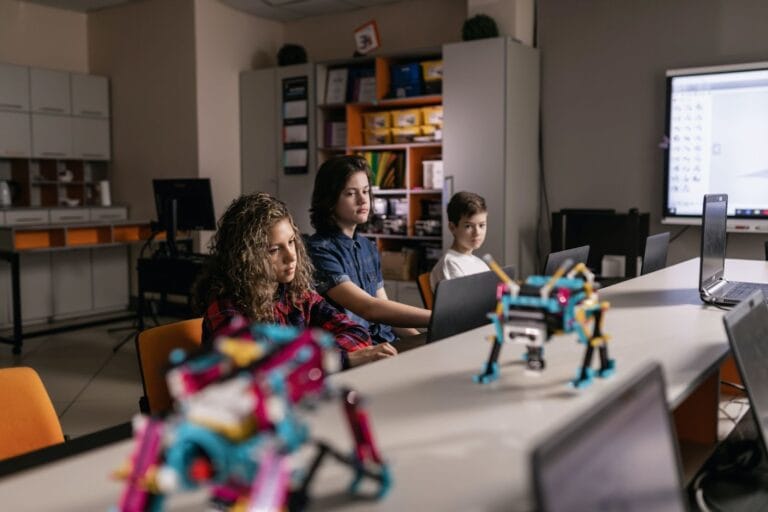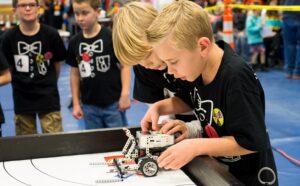The future of robotics is incredibly promising, with the potential to revolutionize the way we live, work, and interact with the world. As robotics technology continues to advance, robots will likely become even more sophisticated and capable of performing tasks that were once thought impossible.
In the future, robots will play an increasingly important role in our lives. While some people may be scared of the possibility of living in a world where machines rule, others may see it as a chance to learn new skills.
‘Regardless of your opinion on robot-led futures, it’s important that kids are prepared for what lies ahead’’.
Robotics for kids is a fun and innovative way to teach children the basics of STEM (Science, Technology, Engineering & Mathematics) concepts.
It offers kids practical insight into programming and building robots. This helps in encouraging important skills such as creativity and logical thinking.
Robotics for Kids can be an entertaining addition to any child’s educational journey!
In this post, we will cover:
· What is robotics?
· Difference between a robot and robotics
· Application for robotics
· What is robotics for kids?
· The benefits of robotics for kids
· Things kids must do to prepare for a high-tech future.
So, get yourself an ice cream or fruit as we delve into this blog post that has been well-researched.
See also: Top 15 Best Computer Programming Schools For Kids in Nigeria
What is robotics?
Robotics is defined as the study that deals with the design, construction, operation, and application of robots.
Robotics is an interdisciplinary branch of computer science and engineering. Designing tools that can aid and support humans is the goal of robotics.
The field of robotics combines concepts from Science, Engineering, and Technology.
The terms Robot and Robotics may sound very similar; however, there are some differences. Let us see what a robot is and the difference between a Robot and Robotics.
What is a robot and how is it different from robotics?
A robot is a type of automated machine that is capable of carrying out many sophisticated activities when instructed to do so or when programmed to do so.
It is a type of machine, a programmable one that is designed to perform specific tasks.
Although some robots are built to resemble humans, most robots are task-performing machines that place more focus on functionality than on expressive aesthetics.
Robots can be human-controlled, take up commands, or can be fully independent and perform tasks without any influence from external factors.
Whereas,
Robotics combines science, engineering, and technology to create machines known as robots.
These robots can perform tasks that assist humans.
Robotics is the branch of study that deals with the design, construction, operation, and application of Robots.
Robotics is applied to create intelligent machines that can sense their environment, process it, and make a decision without manual intervention.
Applications of robotics
According to experts, automation has created a lot of demand for robotics in recent years. Robotics is an important field to serves industries and sectors to boost efficiency and productivity.
The application of robotics can help industries and sectors increase the speed of their manufacturing process and do tasks with precision.
See also: Top 10 Best Kids Coding Languages to Learn
Here are 5 important industries that use robotics:
#1. Health Care Sector
To perform complicated operations, psychological tests like lie sensors, etc. robotics is an important field to be used in the healthcare sector.
#2. Automobile Industries and Manufacturing Sectors
To do repetitive and bulk production Automobile and Manufacturing Sectors use Robotics to increase productivity and precision.
#3. Space Science and Technology Sector
Space Science and Tech use robotics in various applications. From industrial robots to sending robotic humans to space, space robots, navigators, etc. the industry uses robotics.
#4. Defense Sector
To achieve high-quality military equipment, advanced weapons, or information-gathering devices robotics is used in the Military.
A few examples are Drones, cameras, sensors, GPS, and many more.
#5. Agriculture Sector
To modernize the agriculture sector robotics is highly used in devices such as drones to spray insecticides and pesticides, survey drones, GPS, and many more.
What is the future of robotics?
Recent reports forecast the robotic sector to Cross USD 214.68 billion by 2030.
According to the reports, the availability of cost-effective and energy-efficient robots will boost the robotics market growth.
A large contribution to this growth will come from the professional services robots used to perform tasks such as cleaning, delivering, and even transporting.
Now, let’s understand what robotics is for kids and how it can help them to prepare for a high-tech future.
What is robotics for kids?

Robotics for kids refers to any kind of activity that helps kids to understand Robots.
Activities can include robot-building kits and games that get their little hands moving on something fun to more in-depth courses where they can go deeper into understanding the construction and application of robots.
Not only does robotics help them understand S-Science, T-Technology, E-Engineering, and M-Mathematics better but also hones problem-solving capabilities while instilling creativity as well! So what are you waiting for?
Robotics for children is a fascinating, educational way for kids to learn STEM concepts and develop important skills.
Robotics allows kids to learn coding concepts as well. Kids learn coding as a tool to provide instructions to the robots.
See also: The 8 Importance of Teaching Kids to Code in 2024 | 5 Years and Above
What Are The Benefits of Robotics for Kids?
Robotics is an exciting, interdisciplinary field that draws on science, engineering, and technology to teach children essential problem-solving skills.
With robotics, instruction kids can develop critical thinking abilities while staying actively engaged in interesting projects and activities.
Here are some of the benefits of learning robotics for kids:
Fosters STEM learning
Learning robotics can help kids to understand deeper STEM concepts.
Educational programs around the world are now focused on developing courses for students in the interdisciplinary subjects of STEM.
This is so students can enter the fields of science, technology, engineering, and mathematics.
A good Robotics for Kids program can make learning fun and interactive, helping students apply scientific views to real-world experiences.
Robotics classes introduce kids to the world of circuits, wiring, coding, software, and so much more. Therefore constructing a robot enables understanding of STEM across many disciplines.
It helps develop motor skills
Motor skills are the ability to perform specific movements of the body’s muscles to do a certain task. The goal of motor skills is to reduce the energy consumption required for performance.
The growth of these skills helps children increase their cognitive development. This provides independence in learning and exploring.
Robotics for kids will help kids to develop their motor skills through various activities like coding, design, mechanical assembly, and computer simulation as well.
The involvement of children in activities that require learning and hands-on experience in building things (like their very own robots) will help to develop motor skills.
Builds computational skills
Computational skills are defined as the ability to calculate basic addition, subtraction, multiplication, and division problems quickly and accurately.
Robotics is an interdisciplinary field that involves concepts of mathematics, science, and engineering.
To give instructions to robots, kids will learn to give commands through coding which requires a basic understanding of mathematics.
Robotics for kids will help kids learn how robots move in a given environment.
The degree of movement of robots in the surroundings requires computation.
Improves coding skills
Robotics is the study of robots. To make robots function, robots need to have instructions like what to do and how to do it. As a result, instruction is given to robots through coding. Coding is nothing but a set of instructions.
However, learning robotics for kids will make kids learn coding concepts as well with ease.
The ability to code will give kids a new perspective on problem-solving. Also, with the help of coding, kids are bound to learn the different ways in which they can program a robot and give commands of their choice.
Lastly, learning robotics for kids will make kids code to overcome challenges with alternative solutions, as they will sometimes be involved in a trial-and-error method to write the correct code.
See also: 8 Best Coding Games for Kids that Teach Real Programming Concept
Things Kids must do to Prepare for a High-tech Future.
#1. Learn to Code
One of the most important skills for anyone interested in robotics is coding. Kids can start by learning programming languages like Python, Java, or C++.
These languages are used in many different areas of robotics, from controlling the movements of robots to programming their behaviors
#2. Study Science and Math
Robotics relies heavily on science and math, so kids should focus on these subjects in school. This includes learning about physics, biology, chemistry, and calculus, among other topics.
#3. Explore Robotics Kits
There are many different robotics kits available that can help kids learn about robotics and build their robots. These kits often come with instructions and coding tools that can help kids get started with robotics.
#4. Join a robotics club or team
Joining a robotics club or team can provide kids with opportunities to work with other kids who share their interests. They can learn from each other, collaborate on projects, and participate in competitions.
#5. Participate in Robotics Competitions
There are many robotics competitions and challenges that kids can participate in to test their skills and learn from others. These competitions often involve building and programming robots to perform specific tasks.
#6. Learn about AI
Robotics and artificial intelligence (AI) are closely related, so kids should also learn about AI and how it is used in robotics. This includes understanding machine learning, deep learning, and neural networks.
Conclusion
Certainly, robotic machines are all around us. These feats of engineering already help us with many areas of life and could transform the future for us.
But despite a variety of advantages and disadvantages, one thing’s for sure; those with skills in robotics will be highly sought after in the future.
Whether creating, programming, or maintaining robots, there will likely always be work in the field of robotics.
Lastly, by developing these skills and knowledge areas, kids can prepare themselves for a future that is likely to be filled by robotics and other high-tech innovations.
Frequently Asked Questions
5 years and above
Every child deserves an equal opportunity to learn coding and robotics. Coding and robotics are important in every field of life, don’t force them, but rather make them see the reason.
Recent reports predict the robotic sector to Cross USD 214.68 billion by 2030.
According to the reports, the availability of cost-effective and energy-efficient robots will boost the robotics market growth.
Robotics for kids refers to any kind of activity that helps kids to understand Robots.
Activities can include robot-building kits and games that get their little hands moving on something fun to more in-depth courses where they can go deeper into understanding the construction and application of robots.
References
- https://kirankazim.medium.com/how-to-prepare-your-kids-for-a-robot-led-future-
- https://www.futurelearn.com/info/blog/general/introduction-robotics-future-robots




